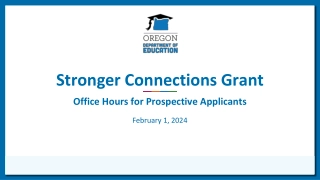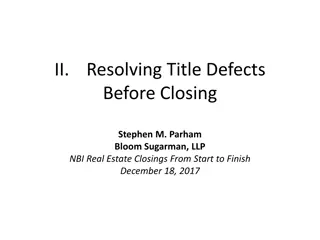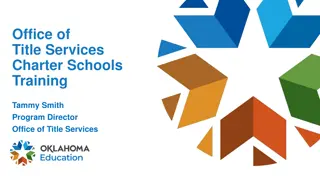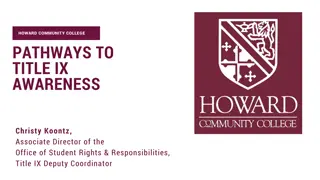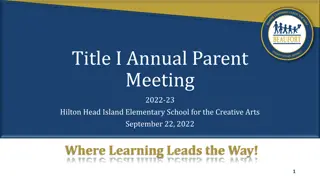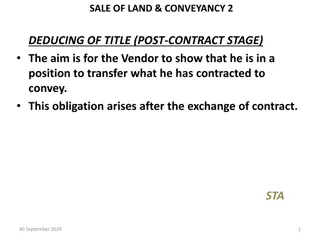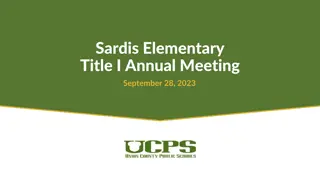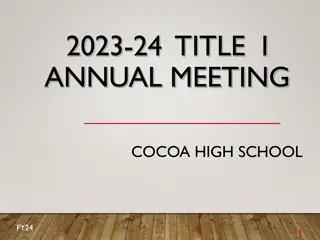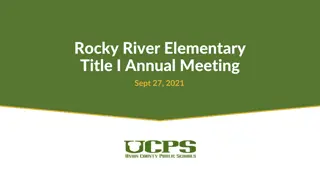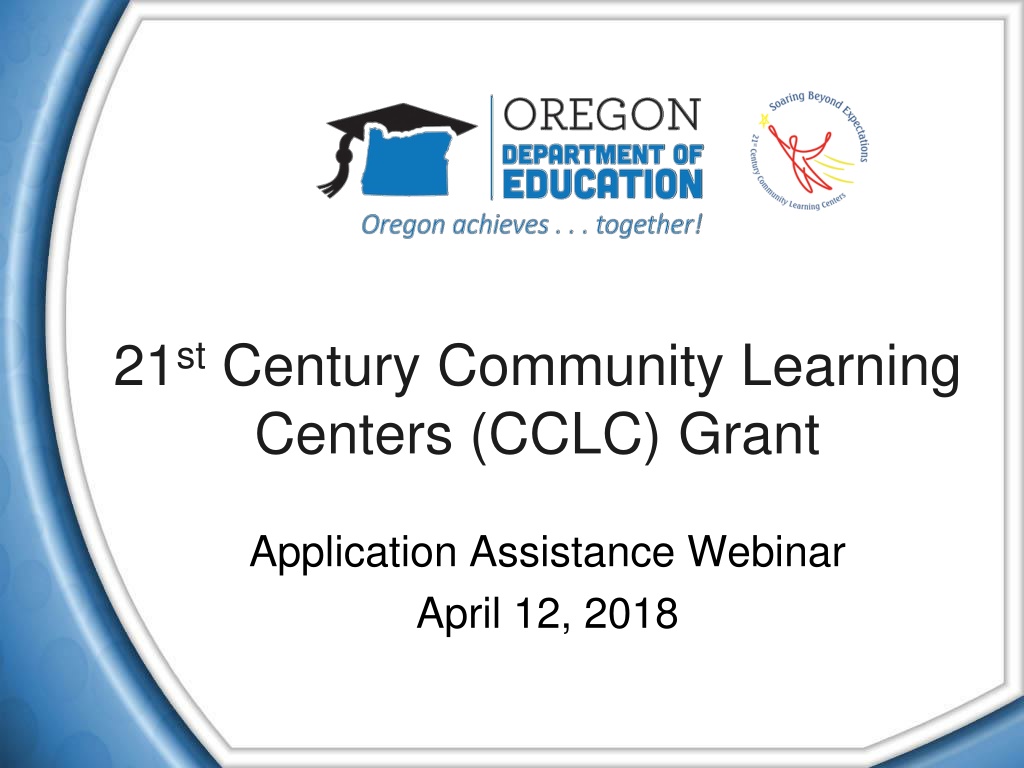
21st Century Community Learning Centers Grant Information
The 21st Century Community Learning Centers (CCLC) Grant aims to establish or expand activities in community learning centers to provide academic enrichment, additional services, and family engagement opportunities. Eligible applicants include local education agencies, non-profit agencies, tribal organizations, and more. Grants are awarded to applicants serving students from high-need schools with a focus on Title I-A schools. The grant cycle is for five years with funding ranging from $100,000 to $500,000 per year.
Download Presentation

Please find below an Image/Link to download the presentation.
The content on the website is provided AS IS for your information and personal use only. It may not be sold, licensed, or shared on other websites without obtaining consent from the author. Download presentation by click this link. If you encounter any issues during the download, it is possible that the publisher has removed the file from their server.
E N D
Presentation Transcript
21stCentury Community Learning Centers (CCLC) Grant Application Assistance Webinar April 12, 2018
Webinar Agenda Application Overview Part 1: General Information Part 2: Application Procedures Part 3: Application Requirements Part 4: Questions Application materials are available for download on the ODE 21st CCLC website at: http://www.oregon.gov/ode/schools-and-districts/grants/ESEA/21stCCLC/Pages/Grants-Guidance.aspx http://www.oregon.gov/ode/schools-and- districts/grants/ESEA/21stCCLC/Pages/Grants-Guidance.aspx http://www.oregon.gov/ode/schools-and-districts/grants/ESEA/21stCCLC/Pages/Grants-Guidance.aspx
Part 1: General Information
Program Purpose Establish or expand activities in community learning centers that: (1) Provide opportunities for academic enrichment to help students, particularly students who attend low-performing schools, to meet the challenging State academic standards. (2) Offer students a broad array of additional services, programs, and activities that are designed to reinforce and complement the regular school day. (3) Offer families of students served by the community learning center opportunities for active and meaningful engagement in their children s education, including opportunities for literacy and related educational development.
Eligible Applicants Local Education Agencies (LEA) Educational Service Districts (ESD) Oregon s federally recognized tribes Non-profit agencies Institutes of higher education Charter schools City or county government agencies Faith-based organizations Community-based organizations For-profit corporations A consortium of 2 or more of such agencies, organizations or entities
Absolute Priority The Oregon Department of Education awards grants only to applicants that primarily serve students who attend school-wide Title I-A schools with Free and Reduced Lunch (FRL) rates of 50% or more. Priority will also be given to applications that: Propose to serve students who attend schools identified for improvement (In Oregon, previously identified as Focus or Priority School). Submit jointly between at least one LEA receiving funds under Title I-A and at least one public or private community organization.
Grant Size and Duration 5 year grant cycle (2018-2023) Renewed annually $100,000 to $500,000 per year Expect to fund approximately 15 to 25 grants 100% funding years 1-3, 75% funding in years 4 and 5. Currently we have 22 programs and approximately 96 centers in the fifth year of the grant.
School Year Services September- June Minimum of 12 hours a week 4 days a week At least 2 hours per day 300 program hours per school year
Regular Attendee The 21st CCLC program is not a drop-in program. To be considered a regular attendee a student must attend a minimum of 30 days. 60 percent of regular attendees are expected to attend 60 + days to benefit significantly from the program. It is expected that 75 percent of enrollees will be regular attendees.
Summer Learning Summer school (optional programming) Operate a minimum of 20 hours a week Minimum of 4 weeks Prioritize regular attendees for 4 weeks Collaborate with other programs providing summer services
Authorized Activities ESSA Changes New language adds: Emphasis on well-rounded education Literacy, including financial and environmental Programs to support a healthy and active lifestyle Services for individuals with disabilities Cultural programs Parenting skills STEM Partnerships with in-demand field of the local workforce/career competencies and readiness
Linking with the School Day Align and coordinate with regular school day curriculum and teachers Incorporate Oregon state standards Align district and school initiatives supporting social, emotional and behavioral needs of students Support school and district goals
Evidence-Based USDE Non-Regulatory Guidance: Using Evidence to Strengthen Educational Investments https://www2.ed.gov/policy/elsec/leg/essa/g uidanceuseseinvestment.pdf What Works Clearinghouse https://ies.ed.gov/ncee/wwc/
11 Elements of Quality Programming 1. Program Administration 2. Staff Qualification and Staff Development 3. Partnerships 4. Evaluation and Continuous Improvement 5. Sustainability 6. Diversity, Inclusion, Access, and Equity 7. Physical Environment 8. Safety, Health, and Nutrition 9. Interactions and Relationships 10. Youth-Centered 11. Social and Emotional Learning and Active Engagement
External Organizations ESSA Changes States must provide a list of prescreened external organizations. The External Organization Profile Application is posted on the ODE 21st CCLC website. Prescreened organizations that meet the criteria will remain on the list for 2 years. Applications will be available for submission from April 11, 2018 through May 25, 2018 at 5:00 PM. External organizations are encouraged (but not required) to register with ODE.
Part 2: Application Procedures
RFA Timeline Date Activity ODE 21st CCLC RFA Disseminated (with info on Webinar in brief) April 3, 2018 April 12, 2018 RFA Technical Assistance for Applicants (Webinar or Go-to-Meeting) April 27, 2018 Peer Review Applications Due May 4, 2018 RFA Due to the Oregon Department of Education by 5:00 PM April-May 2018 Review teams are recruited, selected, and trained for the RFA review External Organization Profile Applications Due by 5:00 PM to be included on the ODE prescreened list May 25, 2018 21st CCLC Grant Recipient Awards are announced by email June 1, 2018 21st CCLC funds are available and implementation may begin August 1, 2018 September 2018 Grantee Orientation: Training and Technical Assistance for new grantees. (TBD)
Electronic Submission Process Both the application (PDF format) and the Budget Program Spending Form (Attachment 8 in Excel) must be emailed to Ann Kaltenbach on or before: May 4, 2018 by 5:00 PM PDF Application as ONE Document No faxes Late or incomplete applications will not be considered
Review Process Teams of independent peer reviewers with expertise in the field of afterschool programming will review the eligible submitted applications. The Peer Review Application is posted on the ODE 21st CCLC website. This review will be based on the specific criteria listed in this RFA and detailed in the scoring rubric. There is no guarantee that submitting an application will result in funding or funding at the requested level. Note: This is a competitive process applicants must score at least 70 points out of the 125 possible points in the narrative and bonus point sections to be approved for funding.
Peer Review Process ESSA Change Peer reviewers may not include any applicant, or representative of an applicant, that has submitted an application for the current application period.
Part 3: Application Requirements
Application Checklist Attachments 1 & 2: Attachment 1- Application Cover Page (Section A) Attachment 2-Program Dashboard (Section B) Narrative: Section C- Program Abstract (Narrative) Section D-Need for Program (Narrative) Section E- Partnerships (Narrative) Section F- Program Goals and Objectives (Narrative) Section G- Program Design (Narrative) Section H- Quality Management (Narrative) Section I-Evaluation Plan (Narrative) Section J- Sustainability and Dissemination Plan (Narrative) Section K- Adequacy of Resources (Narrative) Section L- Competitive Priorities (Narrative) Attachments 3 - 8: Attachment 3- Applicant and Partner Commitment Form (Section E) Attachment 4- Program Goals and Objectives (Section F) Attachment 5- Weekly Schedule (Section G) Attachment 6 Competitive Priorities (Section L) Attachment 7- Assurances Form Attachment 8- Budget Program Spending Form
Required Format The applicant must follow the required format in order to assure a consistent application of evaluation criteria. Grant applications not following this format will not be scored. Please use this as a checklist before submitting your application: 20-page maximum (this does NOT include attachments or priority pages) Double spaced All pages must be standard letter size, 8 X 11 12 point Calibri font ONLY 1 inch on all margins (top, bottom and sides) Document footer with the name of the applicant and page number on each page Tables may be included and must be double spaced (Attachment 4can be single spaced)
Base Grant Components SECTION BASE GRANT APPLICATION COMPONENTS POINTS A Application Cover Page- Attachment 1 0 B Program Dashboard- Attachment 2 0 C Program Abstract- Narrative /5 D Need for Program- Narrative /10 E Partnership and Collaboration Plan- Narrative /10 Applicant and Partner Commitment Form- Attachment 3 F Program Goals and Objectives- Narrative /15 Program Goals and Objectives- Attachment 4 G Program Design- Narrative /15 Weekly Schedule- Attachment 5 H Quality Management- Narrative /10 I Evaluation Plan- Narrative /15 J Sustainability and Dissemination Plan- Narrative /10 K Adequacy of Resources: Budget Spending Form- Attachment 8 /10 Adequacy of Resources- Narrative SUBTOTAL /100
Need for Program Describe the community where students and their families live and go to school Based on local data (Be specific!) Poverty / Free and Reduced Lunch rates Literacy / education levels Needs of the community Describe process for determining need Provide services not currently available
Partnerships At least one LEA and one community-based organization Collaboration in planning and design History of working together Substantial roles in delivery of services, sharing grant resources and having significant involvement in management and oversight Linkage with the school day Program activities are integrated with the regular school day program Clear communication
Program Goals and Objectives Create SMART Objectives! At least all three Grant Purposes At least two objectives for each grant purpose At least 3 activities for each objective All aligned to Oregon s Long Term Goals (Start strong, Transition Successfully, and Graduate College and Career Ready)
Evaluation Plan The evaluation plan must include the following: 1. How the applicant will be accountable for monitoring and reporting on program effectiveness; 2. Describe the applicants capacity, or how the applicant would acquire capacity, to complete the required evaluation components; 3. Describe the evaluation process to complete each required component; and 4. Describe how each proposed program will use formal and informal data to inform program continuous improvement.
Federal Evaluation and Reporting 21APR Program operation (e.g., hours, daily attendance, days of operation) Student enrollment and attendance Academic performance Feeder schools attended by students enrolled in the program, as well as percentages of all students from each feeder school Teacher surveys provided to regular-day teachers of EVERY student. Detailed information on EACH activity provided at EACH center Information on staffing levels and types used by the program in serving students. Information on EACH partner and subcontractor involved with the grant.
Local Program Evaluation ODE requires that each sub-grantees develop and implement an evaluation plan to: Highlight their unique program outcomes and impact Provide evidence that the program provides high quality opportunities for academic enrichment and helps students meet the State and local student academic achievement standards. Identify program strengths, specific recommendations for program improvement, and recommendations for using evaluation results for program improvement and sustainability. Note: Evaluation reports/summaries are due annually and must be made public upon request.
Adequacy of Resources Funds may be used only for authorized activities, and: Indirect Evaluation - No more than 5% Administration Planning - No more than 5% for collaborative planning Professional Development - Include budget for ODE trainings on the next slide
Required Trainings Budget Guidance Staff Member Program Director Program Director, Center Coordinators, and at least 2 key center staff members Time & Expenses 2 Full Days + Travel Expenses 4 Full Days + Travel Expenses + Substitutes
Competitive Priorities *Competitive points will only be awarded if a score of 70 or higher is achieved on base grant. SECTION COMPETITIVE PRIORITY NARRATIVES POINTS L Middle and High School Applications /5 Career and Technical Education (CTE) /10 Support for the Treatment of Trauma, Mental Illness and Conditions for Student Learning /10 Competitive Priorities Attachment 6 0 Assurances Form- Attachment 7 0 SUBTOTAL /25 BASE GRANT /100 PRIORITY POINTS /25 TOTAL POINTS /125
Additional Resources Afterschool Snack Program: http://www.oregon.gov/ode/students-and- family/childnutrition/SNP/Pages/default.aspx https: The Afterschool Alliance: http://www.afterschoolalliance.org/ The National Afterschool Association: http://www.naaweb.org/ Youth for Youth (Y4Y): USDE-sponsored website that houses resources specifically for 21st CCLC http://www.y4y.ed.gov/
Part 4: Questions
Q & A Q RFA page 5: "previously funded Subgrantees must have resolved all monitoring findings and submitted 1) all program information, 2) end of program reports, 3) USDE's data collections system 21 APR, and 4) final budget revisions." Our subgrant ends in FY 17-18. The final APR and evaluation for our current grant is not due until June 30 and Sept. 30, 2018 for the 5 year summary. The new RFA deadline is May 4th. Do we have to have all these documents submitted by May 4th? You will not need to have all your end of grant documentation (e.g., 21APR, Five Year Summary etc.) in before you submit your 21st CCLC RFA. If you were to receive a new award, funding may be withheld if all the required documentation is not submitted for the 2013 2018 grant. A Q Is the maximum grant $500,000 per year for the entire five years of the grant? No, the maximum funding is $500,000 per year for the first three years. The fourth and fifth years, 75% of the $500,000 would be funded. A
Q & A Q Can this grant include Kindergarten? Yes, grantees can work with individual centers to choose to serve this age group. In the past some centers determined it was too long of a day for this age group. A Q Can these grant program funds be used for building or construction? A No, Title IV-B, 21st CCLC grant funds cannot be used to purchase facilities or support new construction. Do schools with FRL rates of 50% or more that are not designated Title I-A schools qualify for consideration under the grant? Example: A middle school with 60% FRL that has Title I-A schools feeding into it, but that isn't designated a Title I-A school. Will they be considered if they meet the 50% or more FRL if they aren't a Title I-A school? Q Yes, your middle school will qualify for consideration under the grant without the Title I-A designation. However, note that applications should primarily serve Title I-A schools with at least 50% or more FRL. A
Q & A What is the criteria for the peer reviewers for the 21st CCLC applications? Will ODE staff be reviewing the applications? How much will reviewers know about best practices in evaluation design as well as Community School program design? Q. The application contains questions about experience with writing and reviewing grant applications; working with youth in education; working in before, after and/or summer learning programs; and asks for a description of knowledge in evidence-based research. There are 24 areas of experience to check if applicable. ODE will check applications for completeness and correct formatting in order for it to be scored by the peer review team. A. Will the attendance of a one-hour program meet the criterion that students have regular attendance, or must they attend a minimum of 2 hours a day? Q The program must operate a minimum of 12 hours in a typical week, or equal four service days per week, be open at least 2 hours a day totaling a minimum of 300 program hours per school year. A
Tips for Successful Submission Start early, Don t wait. Review application requirements and corresponding scoring rubrics for each section Make sure documents are complete and in the right order according to Application Checklist Check required formatting Double and triple check all of the components before you submit.
Additional Questions Raquel Gwynn- Raquel.gwynn@state.or.us Ann Kaltenbach- ann.kaltenbach@state.or.us

